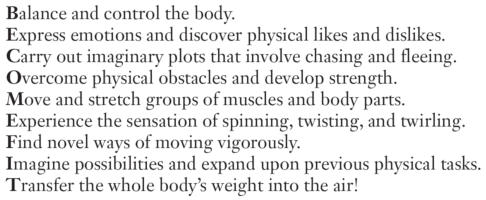Physical activity as play and nutritional goals for children
This is an excerpt from Physical Activity and Health Guidelines by Riva Rahl.
Because infants and young children are not autonomous, guidelines for this population are aimed at parents, caregivers, schools, and the community. In fact, the next chapter outlines multiple sets of guidelines focusing on community or school policy as a way of promoting physical activity for youths. For preschoolers, it is extremely important that age-appropriate opportunities for physical activity and play be available. Playgrounds offer a variety of activities that may be acceptable for a range of ages, making them a sound option for children. Starting with toddlers and extending through older school-aged children, playground equipment allows for independent play with multiple opportunities to challenge the musculoskeletal, neurological, and psychosocial systems. Many of the guidelines for young children include a call to action for communities to continue to provide ample opportunities for outdoor play in the form of playgrounds and outdoor environments. One author summed up the benefits of playgrounds and physical play as allowing children to BECOME FIT (adapted from Clements 2007).
In addition to physical activity, healthy diet and proper nutrition should begin at an early age. The connection between food and fitness is clearly known; parents and caregivers again have an opportunity to play role model for their children by following healthy eating patterns. Sitting down to meals as a family—particularly breakfast—has been shown to improve communication as well as emotional and psychosocial development. Schoolchildren who eat breakfast perform better academically and have a better chance of meeting all their nutritional needs. Getting adequate amounts of macronutrients, vitamins, minerals, and fiber enables children to have the proper energy to live the active lifestyle that is so important for their present and future health status. Recommendations for appropriate activity and nutrition in children appear in both the IOM report on DRIs and the Dietary Guidelines for Americans. While the 2005 Dietary Guidelines for Americans specifically states that its recommendations apply to children aged 2 y and older, the report on DRIs does not make specific reference to the age at which the youth guidelines apply.

SUMMARY
Guidelines for infants and toddlers are important in that they establish the foundation for a lifetime of physical activity and good health. Although exercise per se is not recommended for very young children, there is an emphasis on developmentally appropriate and enjoyable physical activity. Children in this age group use physical activity to build motor skills that will ultimately pave the way for more formalized physical activity as they grow. Properly supervised opportunities for activity, an avoidance of sedentary time, and the ability to observe and pattern healthy physical activity behaviors in parents and caregivers are key components of guidelines for this age group.
More Excerpts From Physical Activity and Health GuidelinesSHOP

Get the latest insights with regular newsletters, plus periodic product information and special insider offers.
JOIN NOW


